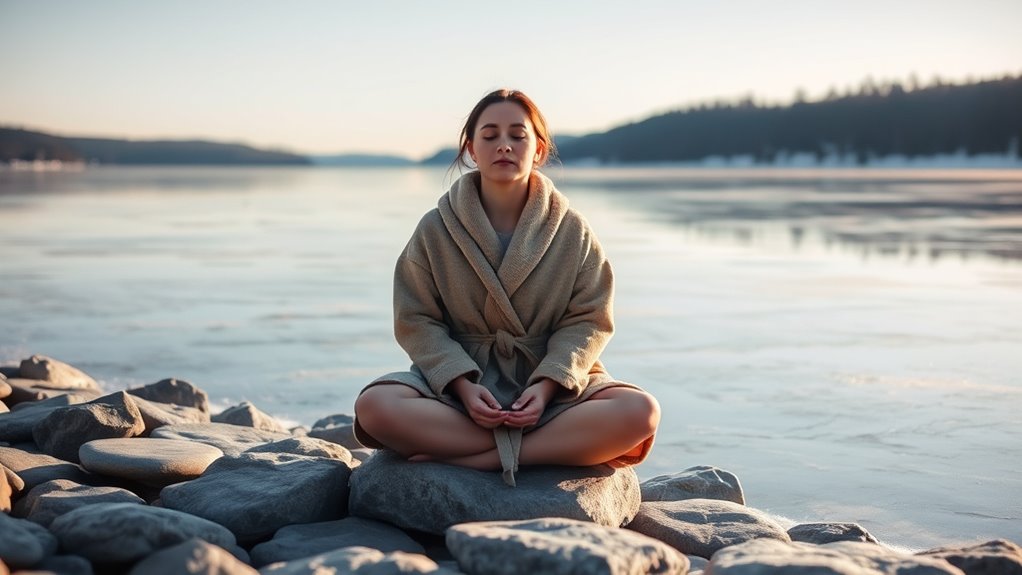Combining a cold plunge with meditation and mindfulness amps up your mental clarity and resilience. The cold water triggers adrenaline and endorphins, sharpening your focus and resetting mental clutter. As you breathe slowly and stay present with sensations, you learn to observe discomfort without judgment, boosting calmness and stress management. Over time, this practice strengthens both your mind and body, helping you face daily challenges with renewed confidence—if you stay curious, you’ll discover how these techniques work together seamlessly.
Key Takeaways
- Cold plunges induce adrenaline and endorphin release, creating a heightened state conducive to mindfulness and mental clarity.
- Focusing on breath and sensations during immersion enhances present-moment awareness and stabilizes the nervous system.
- Combining cold therapy with meditation strengthens resilience to discomfort and reduces mental clutter over time.
- The physical benefits of ice immersion support improved circulation, inflammation reduction, and body awareness, enriching mindfulness practice.
- Long-term integration of cold plunges and mindfulness enhances overall well-being, fostering mental sharpness and physical endurance.

Many people are discovering that combining cold plunges with meditation and mindfulness can deepen their mental clarity and physical resilience. Ice therapy, an intense form of cold exposure, is known for its ability to sharpen focus and clear mental fog. When you immerse yourself in cold water, your body responds with a surge of adrenaline and endorphins, which heightens alertness and promotes a state of wakefulness. This immediate physiological response creates a perfect foundation for mindfulness practices. As you sit in the cold, your mind naturally shifts away from clutter and distraction, forcing you to focus on your breath, sensations, and the present moment. This heightened awareness enhances mental clarity, making it easier to stay centered during meditation and less likely to be pulled into racing thoughts.
The cold immersion acts as a reset button for your mind, stripping away mental clutter and encouraging you to be fully present. When you incorporate meditation into your cold plunge routine, you develop a deeper connection to your body’s responses. You learn to observe your physical sensations without judgment, which cultivates a calm, focused mind even outside the water. Over time, this practice can improve your ability to manage stress, as you become more adept at remaining composed under pressure. The key is to synchronize your breath with your immersion, using slow, deliberate inhalations and exhalations to stabilize your nervous system. This combination not only boosts mental clarity but also trains your body to handle discomfort and stress more effectively.
Ice therapy paired with mindfulness practices also enhances your physical resilience. Cold exposure is a proven method to boost circulation, reduce inflammation, and strengthen your immune system. When you consciously practice mindfulness during cold plunges, you become more attuned to your body’s signals, learning to listen and respond rather than react impulsively. This mindful approach transforms ice therapy from a mere physical challenge into a holistic experience that benefits both mind and body. As you become more comfortable with the cold, your mental clarity deepens because you’re no longer overwhelmed by discomfort; instead, you recognize it as an opportunity for growth. The combination of ice therapy and mindfulness creates a powerful synergy that amplifies your mental sharpness and physical endurance, helping you face daily challenges with greater confidence and calm.
Frequently Asked Questions
Can Cold Plunges Improve Meditation Focus?
Cold plunges can improve your meditation focus by boosting mental clarity and reducing stress. The shock of cold water activates your nervous system, helping you stay present and alert. This heightened awareness makes it easier to concentrate during meditation sessions. Plus, the stress reduction benefits calm your mind, enabling you to achieve deeper mindfulness. Incorporating cold plunges into your routine can enhance overall focus and mental resilience.
What Are the Risks of Combining Cold Therapy With Mindfulness?
The risks of combining cold therapy with mindfulness include potential shock, hypothermia, or increased stress if you don’t perform a proper risk assessment. To stay safe, follow safety precautions like limiting exposure time, gradually acclimating, and monitoring your body’s responses. If you have health issues or are unsure, consult a healthcare professional. Being cautious ensures you enjoy benefits without risking your well-being.
How Long Should Each Cold Plunge Session Last?
For each cold plunge, stick to the duration guidelines of 1 to 3 minutes. This range is generally safe and effective for most people. To find the ideal timing, start with shorter sessions and gradually increase as your body adapts. Listen to your body and avoid overdoing it. Keeping sessions within this timeframe helps you gain benefits without risking hypothermia or excessive stress.
Is Prior Meditation Experience Necessary for This Practice?
No, you don’t need a meditation background to try this practice. Beginners’ tips include starting with short cold plunges and simple mindfulness techniques, such as focusing on your breath. As you gain experience, you can gradually extend your sessions. This approach helps you stay present and manage the cold more effectively, making it accessible regardless of your meditation experience. So, immerse yourself and explore at your own pace.
Can This Combination Help With Anxiety or Depression?
Yes, this combination can help with anxiety and depression by boosting emotional resilience and reducing stress. You might find that regularly practicing cold plunges with meditation creates a calming effect, strengthening your mental health. It’s like building a sturdy fortress against emotional turbulence, where each cold exposure and mindful moment helps you better manage feelings of anxiety and depression, fostering a sense of calm and stability over time.
Conclusion
By combining cold plunges with meditation and mindfulness, you deepen your mental clarity and resilience. For example, imagine someone starting their day with a cold plunge, then practicing mindful breathing; they find it easier to stay calm and focused throughout stressful moments. This powerful combo not only boosts your physical health but also sharpens your mental state, making you more adaptable. Embrace this practice regularly, and you’ll notice a profound shift in your overall well-being.









